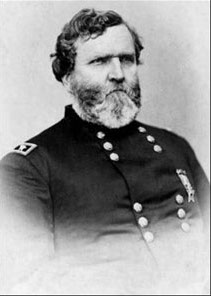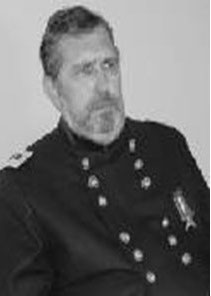George Henry Thomas was born in Southampton County, VA on July 31, 1816. Appointed to West Point in 1836, he graduated 12th in the class of 1840.

He served in the artillery for 15 years, stationed at various coastal forts. He served in the Seminole Wars and in the Mexican War, being brevetted Captain, then Major, for gallantry at the Battles of Monterey and Buena Vista. When Johnston and Lee joined the Confederacy, Thomas was advanced to Lt. Colonel, then Colonel, after the bombardment of Fort Sumter. He commanded a brigade in the Shenandoah during the campaign at 1st Manassas, and was made a Brigadier General of Volunteers in August, 1861. Thereafter he was transferred to the Western theater, seeing action at Mill Springs and Shiloh. He was promoted to Major General of Volunteers to rank in April 1862. Subsequently, he served under Generals Halleck, Buell, and Rosecrans at the Battles of Corinth, Perryville, Stones River, and Chickamauga. For his heroic stand at Chickamauga, where he earned the name, the “Rock Of Chickamauga”, he was made a Brigadier General in the Regular Army in October, 1863. At the Battle of Chattanooga, his troops stormed Missionary Ridge and drove Braxton’s Bragg’s men off the heights in panicked flight.
In Sherman’s successful Atlanta Campaign, Thomas’s Army of the Cumberland made up more than half of the invading force. At the Battle of Nashville, Thomas’s Army virtually annihilated Hood’s force, routing it so completely that it ceased to exist as a military organization. On January 23rd, 1865, he was promoted to Major General, US Army. Following the end of the war, he was Commander of the Department of the Tennessee until 1867, then assigned in 1869 to command of the Division of the Pacific in San Francisco. He died of a stroke there on March 28, 1870, and is buried in his wife’s hometown of Troy, NY in Oakwood Cemetery.
Of the six ranking Lieutenant and Major-Generals in the Union Army at the end of the Civil War, George Henry Thomas was the only one of Southern birth, the only one whose record of military service was uninterrupted throughout his entire career, the only one never to leave his command for a single day from April 10, 1861 when he assumed command of what remained of the 2nd United States Cavalry and 1st Infantry regulars upon their arrival at the Port of New York until the Army of the Cumberland was disbanded on May 9, 1865, the only one to shun self-promotion and turn down opportunities which he did not feel he deserved, the only one who purposely avoided Washington throughout the entire War, the only one never to have met Lincoln, the only one who never lost a battle in which he was in command, and the only General in the entire war to completely annihilate an army in the field.
Yet this man, who served his country for 32 years and in 3 wars – 4 if you consider his service in the West where he wounded by the arrow of a Comanche warrior – was shunned by his family, hated by his neighbors, disowned by his state, kept from promotion, ignored and forgotten by his country, and all for honoring his oath to the Constitution of the United States, remaining loyal to his brother officers-in-arms, and for doing his duty as he saw it!
Speaking before the crowd gathered at the unveiling of the equestrian statue of George H. Thomas in Washington, D.C., General-in-Chief Sherman predicted that the day would come when southerners would make pilgrimages to his monument and that “Brave Thomas will become the idol of the South.”
William S. (Bill) Vosseler
Although some years after its initial release I, like many, first became interested in the American Civil War after seeing Ron Maxwell’s epic film Gettysburg and, having served as a combat infantryman in Vietnam, I could not help but be struck by the bravery I witnessed in this recreation.

Initially, I began my “career” as a Living Historian by portraying the “Radical Republican” Senator from Michigan, Zachariah Chandler, who was probably the foremost antagonist and Meade detractor in Washington, and the founder of the Committee on the Conduct of the War. However, he was a character with limited long term appeal.
During this time I again came across the name of General George H. Thomas and all that I really knew about him was that he was the “Rock of Chickamauga.” However, when I went to look for more information about him, there was little available.
For the next year I searched out everything I could find about the man, who he was as a person, as a soldier, as an officer, and the more I read the more impressed with him I became.
Then one day while surfing the internet I happened upon an explanation of the Coat of Arms or Unit Crest of my combat outfit in Vietnam, the 35th United States Infantry Regiment. What I read hit me like a lightning bolt!

In the upper left hand corner there was a small, white Maltese cross which represented one of the units that formed the nucleus of the 35th Infantry Regiment which was established to defend the U.S. along the Mexican border from Francisco “Pancho” Villa and other raiding bandit gangs following the Mexican Revolution. That unit was the 11th US Regulars of the 2nd Division, 5th Corps, Army of the Potomac.
But atop that little white cross was an even smaller acorn! A tiny, red acorn, which represented the first unit tapped to form the 35th Infantry Regiment. That unit was the 18th US Regulars. The 18th US Regulars who served under Major-General Henry Thomas in the 1st Division of the greatest combat unit in the history of the United States, the 14th Corps, Army of the Cumberland. The link between the two combat infantry organizations sealed it for me.
However removed in time, we were part a bonded combat brotherhood. They were my brothers who fought at Perryville, Stones River, Chattanooga, Chickamauga, Missionary Ridge, Atlanta, Franklin, and Sherman’s March to the Sea under the flag of the 14th Corps. It was they who stood in spirit with those men of the 35th Infantry Regiment who came under fire along the Mexican Border, those who saw combat in WWII at Guadalcanal, the Northern Solomon Islands, and Luzon, in Korea at the Nam River in Pusan, and Inchon. Each of them stood with me in Vietnam at Chu Lai, Quang Ngai, Duc Pho, and Pleiku.
And each of us owe our undying affection to those appointed over us, and especially to our first Commanding Officer, that man who saw the birth of the 14th Corps at Camp Dick Robinson, Ohio on September 15, 1861, Brigadier-General George Henry Thomas, USV.
I have, for a few years now, been intensively studying and portraying General Thomas with the object of bringing recognition to a man I consider the greatest and most ignored Union General to have served during the Civil War.
Bill Vosseler is a 1979 graduate of Rutgers University, married to the former Margaret (Peggy) Wood. He is the owner of Vosseler Enterprises and resides in Garnet Valley, PA. Bill’s military service was as an Sp/4 in the United States Army 1967-1969. He served in Vietnam and was awarded the Combat Infantry Badge; Purple Heart; Good Conduct Medal; Distinguished Unit Citation; Vietnam Campaign Ribbon w/battle star; Vietnam Service Ribbon; and the National Defense Service Ribbon.
He is the Founder of the Union Library Civil War Round Table; Co-Founder and Past Camp Commander of Baker Fisher Camp 101 SUVCW; Executive Director, American Civil War Charitable Trust; a Life Member Disabled American Veterans; a Life Member 12th Armored Division Association; a Member of General George Gordon Meade Society; and a Member 35th Infantry Regiment Association. Two relatives served in the 13th New Jersey Volunteer Infantry and two relatives served in the 15th New Jersey Volunteer Infantry and were killed at Spotsylvania Court House during the Wilderness Campaign.
Bill Vosseler can be contacted at George.Thomas@UnionGenerals.org.